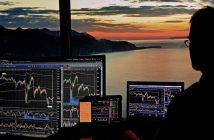I quite agree with what Dennis Ng wrote for Sunday Times yesterday.
“… estimate at which stage of the market cycle we are in… identify the major trend direction… position ourselves accordingly…”
What he’s saying is to estimate the market upturn and buy. He then gave an example: DBS hovered between $8 and $10 for over a year in 2003-2004, and then shot up to $20-$25 in 2007-2008.
Dennis did not explain clearly how to “identify the major trend direction.” There are also doubters and sceptics of his market cycle investing strategy (see discussion in WallStraits where Dennis is an active forummer).
The main criticism is that it’s always hard to time the market – by the time the trend directions are clear, it is almost always too late.
Did I say I “quite agree”?
I would keep it even simpler. As I said previously, just buy during a recession (like now), and sell when the market becomes hot again. But before buying, make sure you have enough savings for emergencies.
How do you know when market is hot again? Easy – you’ll see STI setting record highs, good corporate news almost everyday in the newspapers, students and housewives start dabbling into shares, and our political leaders saying “more good years” or something along that line. 🙂




12 Comments
Just for info, not only must you time the cycles well enough to make good profits; you must also choose the right companies to own.
Some may argue that blue chips are the “safest”, but after looking at what happened to Citigroup and BoA, I would not be so sure. The bigger they are, the harder they fall so to speak.
If you buy the wrong company during a bull market, the company’s share price can still FALL and/or stagnate. Ultimately, one has to understand that what drives share prices over the long-run is corporate performance, earnings and the vital cash flows.
Regards.
Hi,
Guess whats the most important is know what we are buying into. Understand the business the company is in. Read up in trade journals…read blogs…read IPOs of similar companies to understand the industry….watch CNN..
Blue Chips are still GENERALLY safer…Citi and BOA were bluechips but their business model is so complex…its nearly not understandable….
So blue chips are fine but one has to have a grasp on what the company is really doing….
Like what Warren Buffet says…..choose a company that even an idiot can run…ok thats extreme but u get our tokyo drift…
SGDividends.blogspot.com
Use forex as a hedge against falling stock prices
72% in the money for month of March
http://practicalfxtrading.blogspot.com/2009/03/72-success-rate-in-month-of-march.html
FX in the recent period have been breaking from the “conventional” correlation with equities markets.
its important to be clear what you want from your money. do you want to invest, trade or speculate. many times people get confused over what they want. typical example of averaging down and resorting to buy n hold. suddenly a short term position becomes a long term view and small manageable losses morph into monstrous holes!
if things are that easy, there is no need/reason to pay premiums for the services/skills of bankers/fund managers. if statistics are good indicator, how many people in the world are capable of making their living solely thru investment, trading or speculation?
timing is a critical issue. it was easy to make money during bull runs. but it was also equally easy to lose it all when the downturn comes.
therefore, if one is clear in his/her target. losses can be limited. and that is the key between losing n winning.
In my opinion, the market is bottoming. Of course, no one can be sure of when is the exact bottom, but if you can buy near the bottom, you can expect significant gains when the market recovers. I just wrote a post regarding the market nearing a bottom on my site.
http://www.moneytalk.sg/2009/04/nearing-market-bottom.html
I agree with what the author says, combined with an important point which some readers mentioned – choose the right and good companies to own.
As the investment time horizon is at least 3 years or more.
Yes, I bought several blue chips when STI was around 1500. My ROI is now over 50%, but I won’t sell until the next market craze. I have been a trader once, but I think long term investing is far superior to short term trading provided you have some cash to start with (hint: get a job).
Pingback: High earners have engineering degrees - Salary.sg Forums
For those without excess cash for buying and holding on to blue chips, you can still use index funds for this market cycle investing.
For a diversified holdings of an index fund, you can use equity risk premium to estimate the top and bottom areas.
This is definitely better than just buy and hold if your investing time horizon is more than 10 years.
Though they are low cost, index funds do not give out good dividends unlike blue chips. Buying low and selling high is not as hard as “wiseinvestor” made it out to be. You don’t need complex charts and metrics. Those are tools for RMs and fund managers to confuse you. Just read the papers or watch the news to get a sense of the economy. When economy is bad, buy; when good, sell. Admittedly, an average adult would have only 3 or 4 good chances in his life to really exploit this strategy to the max.
guess by now people realised that if they had heed my advice in the article “Make Market Cycles Work for you”, published in Mar 2009 and invested into stocks in March 2009, they would probably have easily made 50% to 0ver 100% returns.
It’s impossible to time the market accurately and consistently over the short term, but it is possible to estimate at which stage of the market cycle we are in… identify the major trend direction… and position ourselves accordingly…”
so dennis, is it a good time to buy now?